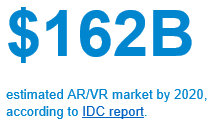Industry forecasters predict that some 25 percent of all investment in AR/VR is in healthcare and that by 2025, the healthcare market for AR/VR will be second only to gaming.
More Precise Care
Building on technologies developed in early jet pilot simulators, AR/VR has long been used for simulation in surgical training. But today’s capabilities are revolutionary. Brain surgeons, for example, can step into a virtual 360-degree model of a specific patient’s brain, built from standard 2D images from that patient’s MRIs. They can move through and view abnormalities and healthy tissue—in high resolution detail and from all perspectives. They can guide patients on a tour of their own pre-op and post-op brains to discuss procedures, risks, outcomes, and prognosis—and navigate through visualizations with surgical teams to plan procedures for operations.
Helping Patients Heal
Patient-centered collaborative VR/AR applications are aiding diagnosis and treatment. Eye-tracking helmets help assess concussive damage at the point of injury—as well as track recovery. 3D motion-tracking games help physiotherapists assess stroke and injury and adjust play that will benefit the patient. The games also help motivate and distract patients from the boredom and discomfort of repetitive movement.
Immersive VR patient experiences are being used to help treat psychological and neurological conditions. Dr. Albert ‘Skip’ Rizzo a psychologist and director of medical virtual reality at the Institute for Creative Technologies (ICT) at the University of Southern California, teamed up with Dell to provide exposure therapy for veterans suffering from PTSD. Patients wearing the USC-developed BraveMind VR headset re-experience sights and sounds relevant to their experience in a safe, controlled environment. The therapist sees what the patient is looking at and reacting to and can manipulate the environment in real time. “Basically, you’re asking the patient to go back and confront and process the difficult emotional memories that surround the trauma,” says Dr. Rizzo.
Educating the Next Generation of Care Givers
AR/VR is also revolutionizing medical learning. Now, instead of limited access to anatomy lab and limited opportunities to practice, students can ‘dissect’ virtual cadavers repeatedly. Care teams can practice procedures on realistic ‘live’ patients who bleed, wince, cough, and so on, to see the consequences of their actions, without risk or harm.
Dr. Carolina Cruz-Neira, a recognized pioneer in VR and director of the Emerging Analytics Center at the University of Arkansas is working with Dell EMC to develop virtual anatomical eyes that students can use. “With virtual reality, we can give each student their own personalized anatomy lab, in which they can dissect and re-dissect to learn anatomy, the basis of all medicine,” says Dr. Cruz-Neira.
The ability to capture medical conditions digitally enables young residents—as well as seasoned physicians—to be exposed to a broad range of anatomies and pathologies.
“All of this firsthand experience in how the human body works—in all of its normal and abnormal variations—will enable doctors to make better diagnoses, leading to better treatments and better outcomes.”
– Dr. Carolina Cruz-Neira, University of Arkansas
Future of AR/ VR in healthcare
Sophisticated visual, audio, olfactory, and tactile sensations and sensitive body-tracking technologies are opening exciting possibilities for AR/VR in all aspects of healthcare. Less expensive, simpler devices, backed by powerful compute, graphics, and middleware platforms, which eliminate the need for custom coding and expensive motion-capture, are drawing greater investment, innovation and entrants into the AR/VR market. And increasingly greater volumes of digital recorded and generated content are making it feasible to build a foundational knowledge base for further educational and technological advancements.
So, when it comes to the future of AR/VR in healthcare, it’s safe to assume that both will continue to dramatically alter clinical care, patient treatment and medical learning for the better.
###
Dave Dimond is a Distinguished Engineer and the Global CTO of Dell EMC’s healthcare business. He is responsible for the international growth of complex technology projects across both established and emerging healthcare economies.
The views, opinions and positions expressed within these guest posts are those of the author alone and do not represent those of Becker’s Hospital Review/Becker’s Healthcare. The accuracy, completeness and validity of any statements made within this article are not guaranteed. We accept no liability for any errors, omissions or representations. The copyright of this content belongs to the author and any liability with regards to infringement of intellectual property rights remains with them.
